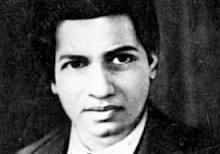
London, November 10: Hence proved! A US scientist has finally proven the mathematical relation - discussed by great Indian mathematician Srinivasa Ramanujan with his mentor G H Hardy in one of his last letters.
Ramanujan, the young genius who died at the age of 32, often managed to leap from insight to insight without formally proving the logical steps in between.
Now proof has been found for a connection that he seemed to mysteriously intuit between two types of mathematical functions, the 'New Scientist' reported.
"His ideas as to what constituted a mathematical proof were of the most shadowy description," G H Hardy, Ramanujan's mentor and one of his few collaborators, had once said.
Ken Ono of Emory University in Atlanta, Georgia, who has previously unearthed hidden depths in Ramanujan's work, was prompted by Ramanujan's 125th birth anniversary, to look once more at his writings.
"I wanted to go back and prove something special," Ono said.
Ono settled on a discussion in the last known letter that Ramanujan wrote to Hardy, concerning a type of function now called a modular form.
Functions are equations that can be drawn as graphs on an axis, like a sine wave, and produce an output when computed for any chosen input or value
The functions looked unlike any other modular forms, but Ramanujan wrote that their outputs would be very similar to those of modular forms when computed for the roots of 1 like the square root -1.
Characteristically, Ramanujan offered neither proof nor explanation for this conclusion.
It was only 10 years later that mathematicians formally defined this other set of functions, now known as mock modular forms.
However, still no one fathomed what Ramanujan meant by saying the two types of function produced similar outputs for roots of 1.
Now Ono and colleagues have exactly calculated one of Ramanujan's mock modular forms for values very close to -1, and said the difference in the value of the two functions, ignoring the functions signs, is tiny when computed for -1, just like Ramanujan said.
The result confirms Ramanujan's incredible intuition, says Ono.
Born in 1887 in Erode, Tamil Nadu, Ramanujan was self-taught and worked in almost complete isolation from the mathematical community of his time, the report said.






Comments
Add new comment